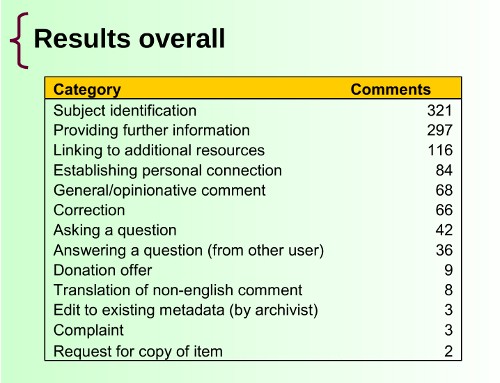I recently stumbled across a SlideShare presentation which analysed three online archival collections and the comments left by visitors.
The comments were gathered together from the three collections and categorised as follows:
I found the results interesting because we receive many comments from web visitors who help identify (photographic) items that we have uploaded to Flickr and here in the Moments in Time series. And the majority of comments correspond to the top three categories above: subject identification; providing further information; and linking to additional resources.
Our image database – Photo Investigator – doesn’t have the functionality for web visitors to add comments directly and so we find these Web 2.0 sites help make our collection more accessible to our web visitors by allowing them to comment and contribute.
A new enhancement to Photo Investigator allows us to link back to these Web 2.0 sites to highlight identifications/contributions by members of the public. While the link remains separate to the ‘official’ information (ie., the additional information sits in the Notes field) it will nevertheless enhance the metadata and therefore the archival collection [see example here].


Bob Meade says:
Yes, interesting results.
I checked the Slideshare presentation and it’s pretty good. It also introduced me to an off-beat photo archive “Beyond Brown Paper”. Interesting to see there that many previously unidentified people in photographs have been named by users.
Congratulations and thanks for introducing the linking within your Photo Investigator to user comments and information.
Anthea Brown says:
@Bob Meade I agree, it looks like a great website. It’s interesting to watch the progress of these community projects – there are benefits for the organisations heading the projects as well as the people who contribute to them.
Here is the link to Beyond Brown Paper for others who might like to have a look.